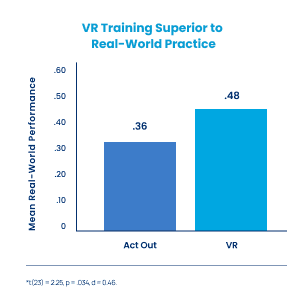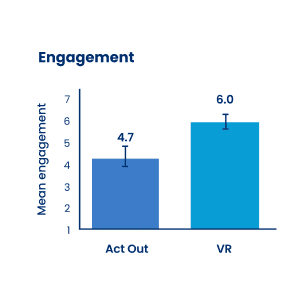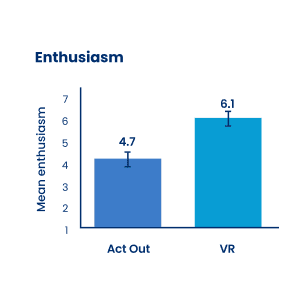Menu
Close
Close
How does practicing a skill in virtual reality (VR) compare to practicing in the real world? To answer that question, Transfr conducted a study at its Louisville research center: Participants (N = 24) learned two culinary tasks (“Stocks” and “Soups and Sauces”) — one via immersive VR simulation and the other via real-world practice (the “act-out” condition). In the act-out condition, participants followed a written recipe and, in the process, used real cooking equipment to physically perform the same steps as in the simulation. A researcher was present during the act-out condition to ensure all steps were completed accurately, similar to how a virtual coach guides learners in the simulation.
Participants returned to the research center 1-5 days after learning (M = 2.4 days) and were asked to demonstrate the steps in both tasks using real cooking equipment. The number of steps accurately performed by the participants was recorded by a researcher.
The proportion of steps accurately performed was significantly higher following practice in VR versus practice in the real world.*

Remarkably, we found that, for learning purposes, VR was not only as good as but actually better than training in the real world. It may be that the highly private and immersive nature of VR helps learners focus, making the experience more memorable and also more enjoyable.
Keith Lyle, PhD
Director, Learning Sciences
After practicing culinary skills in either VR or the real world, participants were asked to estimate the time spent in training. In the act-out condition, participants overestimated time spent by more than 90 seconds, but underestimated time spent in the VR simulation by more than two and half minutes. This difference was statistically significant* and suggests training time in VR flies by faster than in the real world. This may have positive implications for widespread VR training adoption, especially when combined with other positive engagement ratings (see next section).

As many educators can attest, learner engagement is one of the most important elements of delivering any educational content. After both VR and real-world practice, participants rated how much they enjoyed and felt engaged by the practice, as well as how enthusiastic they were to learn other skills using the same form of practice. All ratings were on a 1-7 scale with higher numbers indicating more enjoyment, engagement, and enthusiasm. Participants gave significantly higher ratings to VR practice than realworld practice on all dimensions.**



t(23) = 4.59, p < .001, d = 0.94
**Enjoyment t(23) = 3.35, p = .003, d = 0.68; Engagement t(23) = 4.09, p < .001, d = 0.84; Enthusiasm t(23) = 3.33, p = .003, d = 0.68
VR Career Exploration Reveals New Career Paths for Youths
VR Career Exploration Reveals New Career Paths for Youths